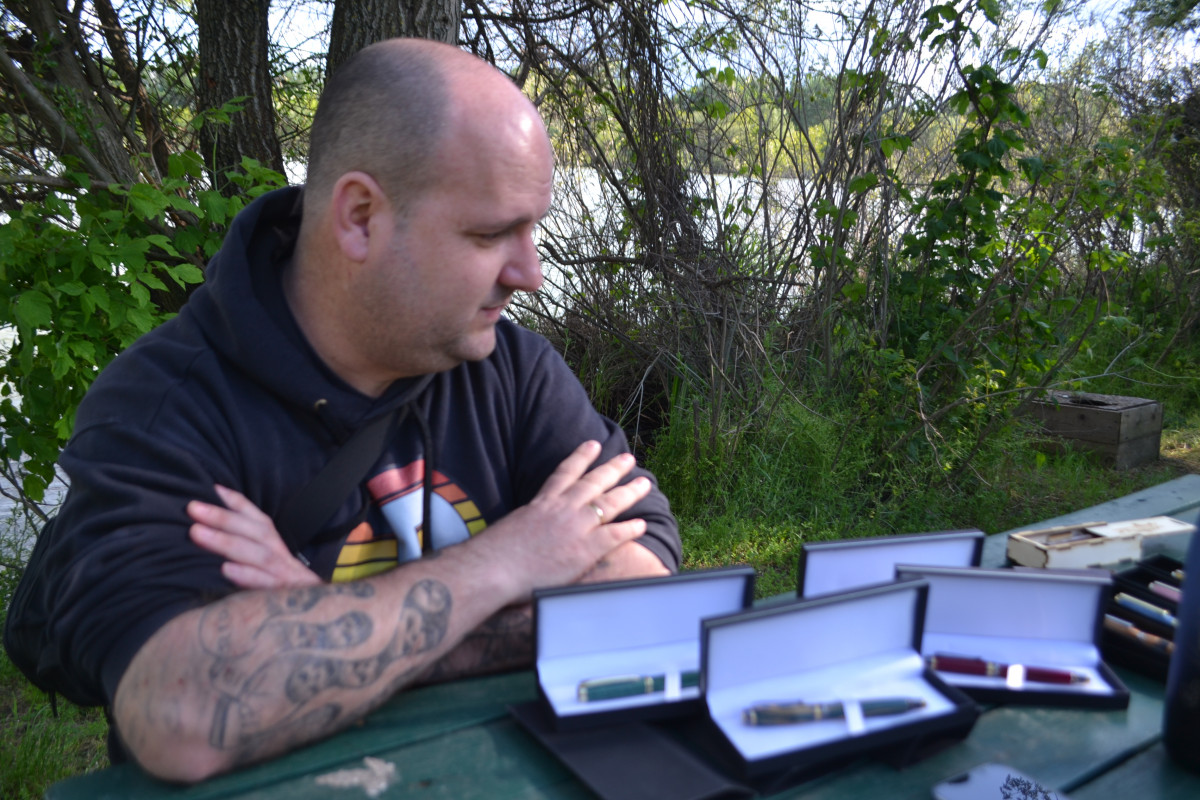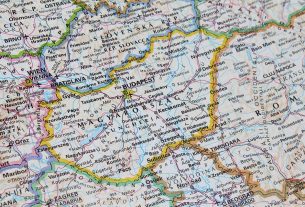Attila Telekes is a programmer and software developer living in Abádszalók. He is committed to working on the waste disposal of the Tisza. He collects garbage, which he recycles, and thus supports a Transcarpathian organization of his choice. We talked to him about his own branded T-shirts, his goals, plans, swallows and mosquitoes, and last but not least, his love for the Tisza.
You make pens from caps, wood, and garbage from the Tisza. How did you get this divine idea?
I have been thinking for a long time about how the garbage fished out of the Tisza could somehow be recycled. Half a year ago, I got the idea to make something out of bottles and caps. The immediate antecedent was that I took out my notebook and when I wanted to write in it, my pen ran out of ink. I turned the apartment upside down, but I couldn’t find one. That’s where the idea came from, that from now on I’m going to make pens from the trash I pick up. I looked online for the necessary raw materials, ordered my first lathe, and not long after, the first column was successfully produced.
What is the column needed for?
There is a wooden frame into which I pack the washed caps, and I fold the heat press over it and start pressing it with its own weight. I then end up with a pasty consistency similar to an overflowed dumpling dough, and when I remove this from the heat, it starts to shrink and firm up. The beginning was not easy, for example, I had to experience for myself at what temperature the plastic starts to crystallize. Selection is very important when it comes to caps, because there are several types in circulation, but only the HDPE2 type plastic works that way for me, so I can’t even mix them.
What percentage of caps are suitable for this operation?
About sixty percent. I only use caps taken from the Tisza, so the cycle will be complete. I fish out the trash, transform it, and use it to support an organization that prevents waste from floating here. Heaven forbid that I couldn’t make a pen, because that would mean that everything is working well outside and we won’t receive any more garbage.
Garbage enters the Tisza not only from abroad but also from Hungary.
Yes, but before that, the two countries are also working hard to bring even more to us. But I always say that cleaning the Tisza is not a question, but a task.
Why do you support Viktor Bucsinszki’s organization?
I learned about Viktor’s work and his daily struggle in Ukraine from my friend Dimitry Ljasuk’s documentary A Tisza nevében (Name of the Tisza). There is no municipal garbage collection there, and he deals with the sorting and removal of waste at his own expense, in addition to his civilian work. My basic philosophy is that if the garbage comes from abroad, then I have to support the person who takes it out there, preventing it from accumulating further. I don’t want to put out the fire, I want to prevent it from starting. After seeing the film, I realized where the real cause of the problem is, and I think that the Színes Tartályok Ökológiai Mozgalom (Color Tanks Ecological Movement) deserves my support. In the person of Viktor, I met a very good-natured and honest person. I was happy when he was here at the Tisza Lake garbage collection organized on the first of April, and also when he visited me.
How much do you support the price of the pens sold?
The price of the pens, as well as the amount of the subsidy, varies. It depends on whether they are made of caps or driftwood, which is named TiszaPen. Lőrinc Fejes, the section engineer of KÖTIVIZIG, helps me in collecting the more special trees. There is a pen in which I put pieces of plastic card, which is how recycling takes place. There are also several types of cases, one is a laser-cut, self-made wooden box, and the other is a handcrafted leather case.
As far as I know, the pens are serially numbered.
Only those made of caps have a serial number and a name. Tisza, Sunset and Tavirózsa.
How many caps are used to make a pen?
Out of forty pieces, and the column is always the most important. Because when I color the hot plastic, shape it, roll it up and then put it in a vise, it must be exactly 20×20 millimeters, and its length is given by the template. If it is smaller or larger, it can cause problems in turn. The size of the cap does not matter at all, as their weight is the same. A block weighs about eighty to eighty-two grams, and only ten grams remain in the finished pen. I also recycle discarded plastic, so I can use 100 percent of the raw material.
How long is the production process?
It varies, but it takes at least three hours to complete a piece. One day I just sort the caps, the next day I save them, the third day I melt them, and by the time I get to the process of making them, about five bars come out. I can make two or even three pens out of plastic, and several pieces out of wood. The latter goes faster, which is why there is also a difference in price.
Unfortunately, you can make more and more because garbage is always available, there is no shortage of caps.
During one of the garbage collections, I collected ten bags of garbage from caps and PET bottles near Kisköre beach. I wanted to make a room divider curtain, but this project did not come to fruition, and the first feathers were made from the remaining caps. And now they bring them to me, I don’t even have to collect them. I also received it from Viktor from Ukraine, and they also brought me nine bags from the garbage collection organized by Dimitry on April 1st. These are directly selected separately by the volunteers, and I would also like to thank them for the hundred kilograms of HDPE caps.
Pen-making is filled with love, and each piece has its own story. It turns off completely. In the meantime, the garbage is running out, support is going to Viktor, so is there any greater happiness?
How many pieces have you created so far?
About eighty. But now I can say that even with pens made from caps, mixed and exotic materials, or very expensive pen structures, I have gone through all the processes and acquired the necessary routine.
Don’t you have two identical pens?
Is not. To highlight something more special, I have a piece that I made from poplar wood, from the outgrowths of trees, and treated with orange wood oil. Each one is different and also unique.
What is the feedback like? Are there orders coming?
I received a lot of positive feedback. Most recently, Gáspár Szente, the percussionist of the Hungarian State Opera House, said that he really liked the unique pen. The orders keep coming in, but some more publicity is needed so that as many people as possible support the cause.
Aren’t you worried that the use of pens is decreasing in the digitized world?
I also sense the trend, but I used a little trick: I installed a touch screen function on the end of some pens, so they can be used for phones and tablets. In addition, I really want to get more people to use handwriting.
Abandon the keyboard?
As much as possible.
Why do you think handwriting “needs” to be brought back?
Because writing is a beautiful and fundamental thing. Unfortunately, many people cannot even write correctly. A four-year-old child can handle the phone perfectly, but if you give him a crayon, he doesn’t even know how to use it.
In one of your Facebook posts, you wrote “I managed to realize an 18-year-old plan, I can release two own brands”. What does this cover?
In 2004, I worked for Uncle Gyula Karsa in Sarud, where we made screen-printed T-shirts for the Athens Olympics, and I really liked this production process. So much so that in one night I printed eight hundred T-shirts alone. This was the era when figure-hugging, skateboard t-shirts, which I also liked, were in fashion. My passion for drawing was already present in my life, so I asked Uncle Gyula to help me. Of course, I received a positive response, but unfortunately, the joint work came to an end. Then I didn’t get to the point of having my own branded T-shirt. Then two years ago, I started making souvenirs, mugs, lanyards and t-shirts. That’s when I came up with these two brands. At sunrise, you can see a Kisköre bench at the sign Lake (tó), if you look at it from the direction of Abádszalók. River refers to the pollution of the Tisza, and its pattern illustrates the stacking of torn colored papers on top of each other.
Do you also support Viktor’s work with the River and Lake T-shirts sold?
Yes, I will support Viktor’s organization with HUF 500 from the price of the T-shirts sold.
For many people, the love of the Tisza is a kind of love, just as it is for you.
I really like living here and I can’t leave here, even though I’ve tried. I’ve worked in many places, but nowhere have I felt what I feel here, and I can’t even put this feeling into words. I’m not talking about simple homesickness, but about the freedom that can only be taken away from you if you have to leave here. I live eight hundred meters from the water, and if I’m in a bad mood, I just sit on the beach, and from then on everything is completely different. It is always refreshing to look at the water because it puts one’s soul in order.
Nature conservation is not far from your heart either.
Hungary’s swallow population has halved in the last twenty years, and this is strongly felt around Lake Tisza because there have been an awful lot of mosquitoes. My biggest plan is to make swallow nests from PET bottles using 3D technology. I already have a prototype of my own design, I also spoke with the ornithological institute, who see no obstacle to the swallow moving into it. What I’m making is just a frame, which needs to be smeared with mud afterward.
Would installing swallow nests solve the mosquito problem in Lake Tisza?
I think it would be significantly reduced. This year, I would like the technology to be implemented, and then we could start their production at the end of the year. Because the swallows come back in the spring, occupy and build nests. I have already talked to mayors about this – they liked my idea. The nests would cost a few thousand HUF, they could be placed in the right places with public workers, and school children could cover them with mud. With this, the little ones would learn at a very early age that I could teach them that they shouldn’t throw away garbage, not least because useful things can be made from it.
(Translated from Judyt Rontó, Szabolcs Szilágyi’s article from Debrecen Sun.)




















